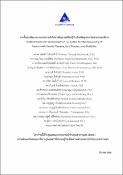Establishment and Development of the System for DNA Sequencing of Patients with Genetic Diseases, Rare Diseases, and Disabilities
วรศักดิ์ โชติเลอศักดิ์;
Vorasuk Shotelersuk;
กัญญา ศุภปีติพร;
Kanya Suphapeetiporn;
ประสิทธิ์ เผ่าทองคำ;
Prasit Phowthongkum;
ฑัณฑริรา พรทวีทัศน์;
Thantrira Porntaveetus;
ชูพงศ์ อิทธิวุฒิ;
Chupong Ittiwut;
รุ่งนภา อิทธิวุฒิ;
Rungnapa Ittiwut;
จุรีรัตน์ โพธิ์แก้ว;
Chureerat Phokaew;
นรินทร์ อินทรักษ์;
Narin Intarak;
ศิรประภา ทองกอบเพชร;
Siraprapa Tongkobpetch;
เฉลิมพล ศรีจอมทอง;
Chalurmpon Srichomthong;
อัจจิมา อัศวพิทักษ์สกุล;
Adjima Assawapitaksakul;
อาญญฬิฎา บัวสงค์;
Aayalida Buasong;
วรรณนา เชฎฐ์เรืองชัย;
Wanna Chetruengchai;
ธนากร ธีรภานนท์;
Thanakorn Theerapanon;
กรรณธ์ญาณัฐษ์ ทวีรัชธรรม;
Kanyanut Thaweerachathum;
ฐิติยา วรรณไสย;
Thitiya Wannasai;
Date:
2564-12
Abstract
 | ผลงานวิชาการเหล่านี้เป็นลิขสิทธิ์ของสถาบันวิจัยระบบสาธารณสุข หากมีการนำไปใช้อ้างอิง โปรดอ้างถึงสถาบันวิจัยระบบสาธารณสุข ในฐานะเจ้าของลิขสิทธิ์ตามพระราชบัญญัติสงวนลิขสิทธิ์สำหรับการนำงานวิจัยไปใช้ประโยชน์ในเชิงพาณิชย์ |
Fulltext
Total downloads:
| Today: | 0 |
| This month: | 1 |
| This budget year: | 3 |
| This year: | 12 |
| All: | 59 |
Collections
-
Research Reports [2531]
งานวิจัย

